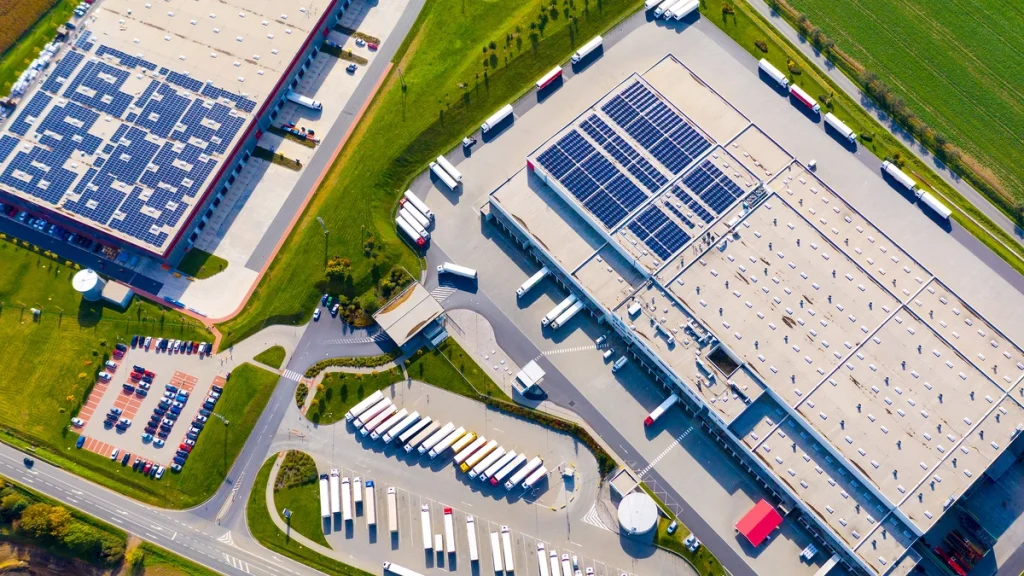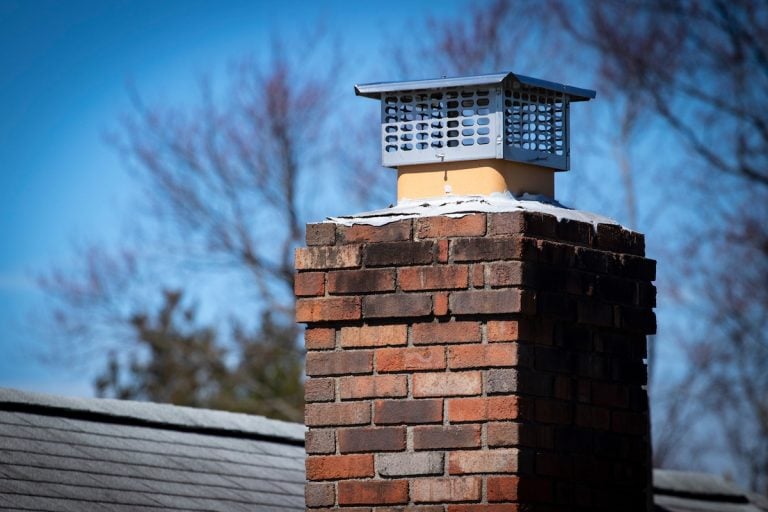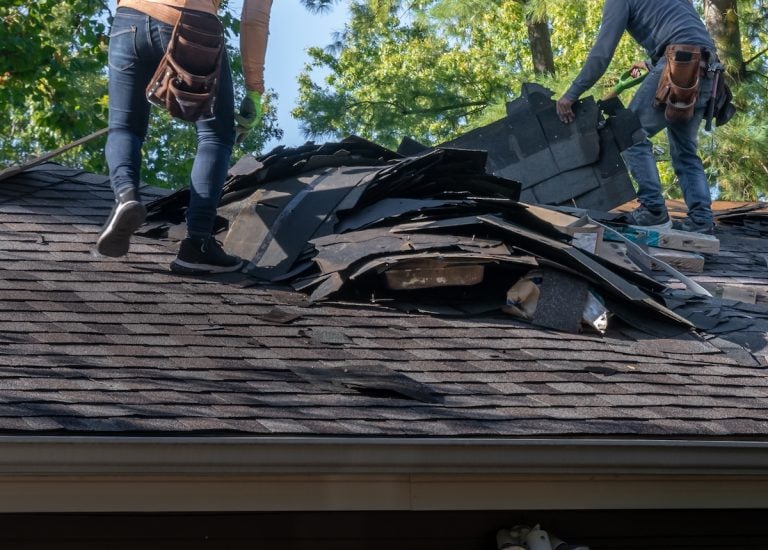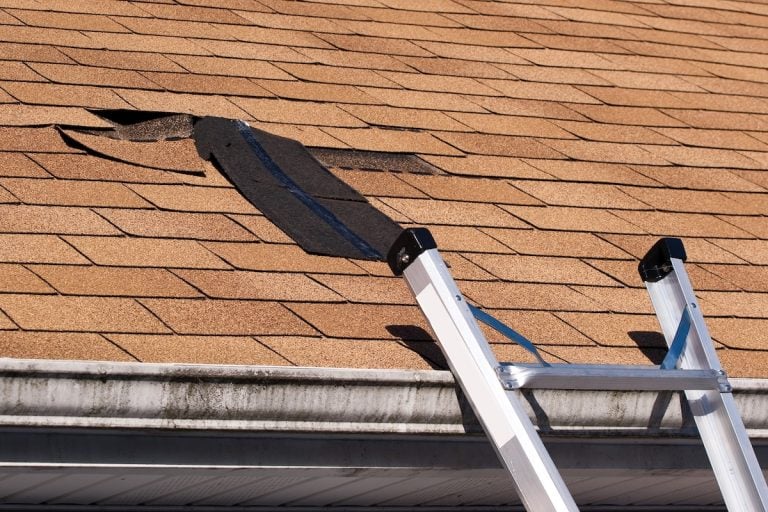The roof of a commercial building is not just a protective cover; it’s a critical element that ensures the safety, functionality, and longevity of your business infrastructure.
Choosing the right commercial roof is essential for maintaining a secure and efficient workspace. But how do you know where to start? After all, most of us aren’t exactly roofing experts.
Lucky for you, we are! In this blog post we’ll dive deep into 4 commercial roof types, exploring:
- What sets them apart from residential roofs
- Installation costs
- Maintenance tips
- When it’s time for a replacement
Key Takeaways
- Commercial vs. Residential: The article highlights the fundamental differences between residential and commercial roof types in terms of materials, installation, and maintenance requirements, emphasizing that one is not just a larger version of the other.
- Four Reliable Options: You’ll find a detailed breakdown of four of the most dependable commercial roof types on the market: Built-Up Roofing (BUR), Single-Ply Membrane Roofing (TPO and EPDM), Metal Roofing, and Modified Bitumen.
- Costs & Maintenance: The post also provides insight into the average cost of a new roof installation and offers crucial maintenance tips to ensure the longevity and performance of your business’s roofing system.
Commercial vs. Residential Roofing: A Different Kind of Challenge
While both commercial and residential roofs protect a building from the elements, they are fundamentally different in their design, materials, and maintenance needs. A commercial roof is not just a larger version of a residential one; it’s a completely different system built to handle unique demands, particularly those posed by the climate and infrastructure of our region. The variety of commercial roof types available reflects this specialization.
The Material Difference: Built to Last
The different commercial roof types require exceptionally durable materials to withstand heavier foot traffic, intense sun, and fluctuating temperatures. Unlike residential asphalt shingles, commercial roofs are built with robust materials like TPO, PVC, EPDM, and metal. These commercial roofing systems are designed for superior resistance to punctures and UV radiation, which is essential for commercial buildings that house extensive rooftop equipment and must endure severe weather.
Installation and Maintenance: A Specialized Roofing Approach
Installation for any commercial roof types, but especially the low-slope designs common on large structures, requires specialized techniques to prevent water pooling and ensure proper drainage. Due to their complex design and rooftop equipment, they also need a more rigorous and proactive commercial roofing maintenance schedule than residential roofs. Regular inspections and specialized care are key to catching minor issues before they become costly leaks, especially after severe weather events.
4 Durable Commercial Roof Types

Choosing the right roofing material is one of the most important decisions you’ll make for your commercial property. The ideal system must withstand everything from intense UV exposure to heavy rainfall and the occasional severe storm common in the Charlotte, North Carolina area. While many options exist, we’ve narrowed down the four most reliable commercial roof types that provide exceptional durability and long-term protection for your business, ensuring you’re prepared for the unique weather challenges of the Queen City.
1) Built-Up Roofing (BUR):
Built-up roofing, often referred to as “tar and gravel” roofs, consists of multiple layers of bitumen alternated with reinforcing fabrics.
✅ Pros:
- Excellent waterproofing capabilities.
- Long lifespan, lasting up to 30 years with proper maintenance.
- Resistant to UV rays and weather damage.
❌ Cons:
- Heavyweight may require additional structural support.
- Installation can be labor-intensive.
- Potential for leaks at seams over time.
2) Single-Ply Membrane Roofing:
Single-ply membranes, such as TPO (thermoplastic polyolefin) and EPDM (ethylene propylene diene terpolymer), offer a lightweight and flexible roofing solution.
✅ Pros:
- Quick and easy installation, reducing labor costs.
- High reflectivity, improving energy efficiency.
- Resistant to punctures and tears.
❌ Cons:
- Prone to shrinkage over time.
- Susceptible to damage from sharp objects.
- Lifespan typically ranges from 10 to 25 years.
3) Metal Roofing:
Among the commercial roof types, metal roofs have become very popular because of their durability, longevity, and aesthetic appeal. They can be made from various materials, including steel, aluminum, and copper.
✅ Pros:
- Exceptional durability, lasting 40 years or more.
- Lightweight construction.
- Reflective properties reduce energy costs.
❌ Cons:
- Higher initial cost compared to other materials.
- Expansion and contraction may cause noise in certain conditions.
- Prone to denting from hail or heavy objects.
4) Modified Bitumen Roofing:
Modified bitumen roofing is an evolution of traditional BUR, incorporating polymer-modified bitumen sheets for added flexibility and strength.
✅ Pros:
- Superior flexibility, ideal for buildings with frequent temperature fluctuations.
- Easy installation with heat welding or cold adhesive.
- Excellent waterproofing properties.
❌ Cons:
- Vulnerable to punctures from sharp objects.
- Limited color options compared to other roofing materials.
- Lifespan typically ranges from 10 to 20 years.
Average Cost of Installing a New Commercial Roof
The cost of installing a new commercial roof varies depending on several factors. And one of the most important is, in fact, deciding which of the commercial roof types is the most suitable option. After that, your reliable local roofing contractor will make sure to help you measure the roof’s size, its location, and, of course, labor costs. On average, you can expect to pay between $5 to $12 per square foot for materials and installation. For example, a 10,000 square foot roof could cost between $50,000 to $120,000.

Maintenance Tips for Your Commercial Roof
Regular maintenance is crucial for extending the lifespan of your commercial roof and preventing costly repairs. No matter which of these commercial roof types is the case, professional roofing maintenance is a must for long-term durability and solving issues before they cause further damage. Here are some maintenance tips to consider:
- Inspect your roof regularly for signs of damage, such as cracks, leaks, or loose flashing.
- Clear debris, leaves, and other obstructions from the roof surface and gutters.
- Trim overhanging branches to prevent damage from falling limbs.
- Check for ponding water, which can indicate drainage issues.
- Schedule professional inspections and maintenance at least twice a year.
When to Replace Your Commercial Roof
Despite regular maintenance, there will come a time when repairing your commercial roof is no longer cost-effective, and replacement becomes necessary. Here are some signs that indicate it’s time for commercial roof replacement:
- Multiple leaks or persistent water damage.
- Extensive mold or mildew growth.
- Significant membrane or shingle deterioration.
- Structural damage or sagging.
- Roof nearing the end of its expected lifespan (typically 20 to 30 years for most commercial roofs).
All Commercial Roof Types Function on Different Systems
Understanding the commercial roof types operates on a different system is crucial for proper installation and maintenance. The choice isn’t just about the material; it’s about the complete system designed to protect your building, which is especially important for handling the unpredictable weather in Charlotte. While they all serve the same purpose, their core functionality varies.
Key System Differences:
- TPO & PVC (Thermoplastic Systems): These are single-ply membranes that are heat-welded at the seams to create a seamless, waterproof barrier. This process ensures a robust defense against water intrusion, which is essential for low-slope roofs.
- EPDM (Rubber Membrane Systems): EPDM is a durable, synthetic rubber roofing membrane. It’s often installed using a fully adhered system, mechanically fastened, or ballasted with rock. Its flexibility makes it a great choice for roofs with a lot of movement.
- Metal Roofing Systems: Among the commercial roof types, these are made of interlocking metal panels that are mechanically fastened. This system is known for its incredible longevity and ability to withstand high winds and hail, a significant advantage for commercial properties in the Carolinas.

Choosing the right option among these commercial roof types requires careful consideration of factors such as durability, cost, maintenance requirements, and aesthetic appeal. By understanding the various options available and their respective pros and cons, you can make an informed decision that ensures the long-term integrity and functionality of your business infrastructure. Remember to prioritize regular maintenance and inspections by reliable roofers to maximize the lifespan of your commercial roof and minimize the risk of costly repairs or premature replacement.
Ready to move beyond the research and find the ideal roofing solution? Contact Roof Medic today to speak with one of our specialists who can help you navigate your options and get the right choice among our commercial roof types installed for your business in the Charlotte area.
Frequently Asked Questions
What is the best commercial roof type for my business?
The “best” commercial roof depends on several factors, including your building’s location, budget, the local climate (like the heavy rain and seasonal changes in the Charlotte area), and the type of business you run.
What is the typical lifespan of a commercial roof?
The lifespan varies significantly by material and maintenance. While a well-maintained metal roof can last 40-70 years, other popular options like TPO and EPDM typically last 20-30 years. Regular professional inspections and proactive maintenance are key to maximizing your roof’s lifespan.
How do I know if my commercial roof needs to be replaced?
Signs that your roof may need a replacement include persistent leaks, extensive blistering or cracking, large areas of water ponding, or significant damage to the membrane. An expert can perform an assessment to determine if a repair or a full replacement is the most cost-effective solution.
How does the cost of different commercial roof types compare?
The initial cost of a commercial roof varies widely based on the material. Single-ply membranes like TPO and EPDM are often the most cost-effective upfront, while metal roofing systems tend to have a higher initial cost. However, the higher durability and longer lifespan of materials like metal can make them a more economical long-term investment, as they require less frequent replacement and maintenance.




